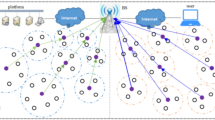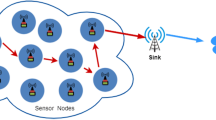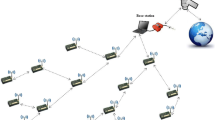Abstract
Recent developments and advances on electronics and wireless telecommunications have enabled researchers to design and produce low-power and small sensors with reasonable prices which can be used for various applications. Wireless multimedia sensor networks are a new subset of WSN family which is capable of doing operations such as receiving multimedia information, i.e. video, sound, photo and numerical data from the surrounding environment, processing them and transmitting them. Due to high transmission rate and the explosive feature, the transmission of video flows in WSNs concerned with several challenges. Congestion also leads to the loss of packets and costly retransmission of packets. Consequently, the limited energy of the sensor nodes is wasted. Accordingly, in this paper, using fuzzy logic, a new congestion control method was proposed for these networks. In the proposed method, congestion announcement and control are carried out by using three main parameters, i.e. the remaining energy level of the node, load density and accessible detection bandwidth. The results of evaluations, done via OPNET 11.5, indicated that using the proposed method led to an average delay reduction in packet arrival. Also, less energy of the nodes is consumed and network lifetime is enhanced. Multimedia is used for novel approaches such as the followings: communications, commerce, education, entertainment, personal locator services, advanced health care, control systems, traffic avoidance and execution and in Information Technology.

















Similar content being viewed by others
References
Aghdam, S. M., Khansari, M., Rabiee, H. R., & Salehi, M. (2014). WCCP: A congestion control protocol for wireless multimedia communication in sensor networks. Ad Hoc Networks, 13, 516–534.
Wang, C., Sohraby, K., Lawrence, V., Li, B. & Hu, Y. (2006). Priority-based congestion control in wireless sensor networks. In IEEE International Conference on Sensor Networks, Uubiquitous, and Trustworthy Computing (SUTC 2006) (pp. 22–31). Taichung, Taiwan, IEEE Computer Society.
Yaghmaee, M. H., & Adjeroh, D. A. (2009). Priority-based rate control for service differentiation and congestion control in wireless multimedia sensor networks. Computer Netsworks, 53(11), 1798–1811.
Chen, S., & Yang, N. (2006). Congestion avoidance based on light weight buffer management in sensor networks. IEEE Transactions on Parallel and Distributed Systems, Special Issue on Localized Communication and Topology Protocols for Ad Hoc Networks, 17, 934–946.
Wan C. Y., Eisenman S. B. & Campbell A. T. (2003) CODA: Congestion detection and avoidance in sensor networks. In The Proceeding of ACM Sensys’03, Los Angeles, California, USA.
Hull, B., Jamieson, K. & Balackrishnan, H. (2004). Mitigatting congestion in wireless sensor networks. In Proceedings of Sensor Systems 04, 2004 (pp. 134–147).
Ee, C. & Bajsys, R. (2004). Congestion control and fairness for many-to-one routing in sensor networks. In Proceedings of ACM Sensor Systems.
Wang, C., Li, B., Sohrabi, K., Daneshmand, M., & Hu, Y. (2007). Upstream congestion control in wireless sensor networks through cross-optimaization. IEEE Journal on Ed Area in Communication, 25(4), 786–795.
Vuran, M. C., & Akyildiz, I. F. (2010). XLP: A cross-layer protocol for efficient communication in wireless sensor networks. IEEE Transactions on Mobile Computing, 9(11), 1578–1591.
Zawodniok, M., & Jagannathan, S. (2007). Predictive congestion control protocol for wireless sensor networks. IEEE Transactions on Wireless Communication, 6(11), 3955–3963.
Adjeroh, D. & Yaghmaee, H. (2008). A new priority based congestion control protocol for wireless multimedia sensor networks. In: International Symposium on A world of Wireless, Mobile and Multimedia Networks, Newport beach, CA, USA (pp. 1–8) June 23–26, 2008.
Huang, R., Fang, Y., Li, S., Yin, X., & Zhou, X. (2009). A fairness-aware congestion control scheme in wireless sensor networks. IEEE Transactions on Vehicular Technology, 58(9), 5225–5234.
Tao, L. Q. & Yu, F. Q. (2010). ECODA: Enhanced congestion detection and avoidance for multiple class of traffic in sensor networks. Transactions on Consumer Electronics, 56(3).
Basaran, C., Kang, K. D., & Mehmet, H. S. (2010). Hop-by-hop congestion control and load balancing in wireless sensor networks. In 2010 IEEE 35th conference on local computer networks (LCN) (pp. 448–455). IEEE.
Akyildiz, I. F., Akan, O. B. & Sankarasubramaniam, Y. (2003). ESRT: Event-to-sink reliable transport in wireless sensor networks. In Proceedings of ACMMobihoc’03, June 1–3, 2003, Annapolis, Maryland.
Author information
Authors and Affiliations
Corresponding author
Rights and permissions
About this article
Cite this article
Tabatabaei, S., Omrani, M.R. Proposing a Method for Controlling Congestion in Wireless Sensor Networks Using Comparative Fuzzy Logic. Wireless Pers Commun 100, 1459–1476 (2018). https://doi.org/10.1007/s11277-018-5648-y
Published:
Issue Date:
DOI: https://doi.org/10.1007/s11277-018-5648-y




